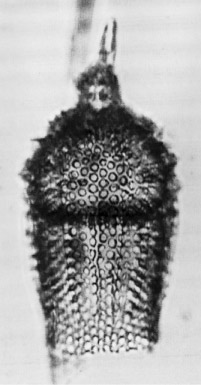 Theocyrtis
tuberosa Riedel, emend.
Sanfilippo et al.
Theocyrtis
tuberosa Riedel, emend.
Sanfilippo et al. Theocyrtis
tuberosa Riedel, emend.
Sanfilippo et al.
Theocyrtis
tuberosa Riedel, emend.
Sanfilippo et al.Theocyrtis tuberosa Riedel, 1959, p.298, pl.2, figs.10-11; Sanfilippo et al., 1985, p.701, figs.32.1a-d
Cephalis elongate, subdivided into three(?) indistinct loculi, with rough surface and subcircular to circular pores. Apical horn short, stout, three-bladed, often irregular in form or forked. Thorax subhemispherical, with pronouncedly tuberose surface due to low irregular protuberances, and subcircular to circular pores showing a tendency to longitudinal alignment. Lumbar stricture indistinct externally. Abdomen subcylindrical, somewhat contracted distally, usually with ragged termination, and having a plicate wall in which adjacent plicae are separated by two to four longitudinal rows of subcircular to circular pores (Riedel, 1959).
Based on 30 specimens. Length of apical horn 13-50 µm; of cephalis 28-50 µm; of thorax 83-133 µm; of abdomen 38-168 µm. Breadth of cephalis 35-45 µm; of thorax 120-175 µm (Riedel, 1959).
T. tuberosa is distinguished from other pterocorythids by the tuberculate surface of the thorax, but for further discussion of the distinction of early forms from T. annosa, and phylogenetic relationships, see discussion under that heading (Sanfilippo et al., 1985).
Overall form cylindro-conical, with the bladed vertical horn as long to about twice as long as the cephalis, and the thorax campanulate to inflated. Thoracic surface pronouncedly tuberculate in late specimens, less so (and often indistinctly longitudinally ribbed) in early ones. Abdomen of very variable length, with no differentiated peristome, and in many specimens having longitudinal plicae in its wall. Thorax 85-135 µm long, 120-175 µm broad. Until now early forms lacking pronounced tubercles on the thorax have been excluded from this species, but they are now included because of the difficulty of satisfactorily separating "pronounced" from less pronounced tubercles, and in order to provide a taxonomic home for co-occurring, obviously related, longitudinally plicate forms superficially resembling T. annosa (Sanfilippo et al., 1985).
T. tuberosa evolved from a small, unnamed Theocyrtis sp. (Sanfilippo and Riedel, 1992, p.20, pl.1, figs.20-23) in the late Eocene/early Oligocene.
This species is common in late late Eocene to early late Oligocene assemblages from low and middle latitudes of all ocean basins. Its morphotypic first appearance lies within the Calocyclas bandyca Zone. Its morphotypic last appearance lies within the Dorcadospyris ateuchus Zone.
Additional illustrations can be found in Riedel and Sanfilippo, 1970, pl.13, figs.8-10; 1971, pl.3D, figs.14-18; 1978a, pl.1, figs.10-11.